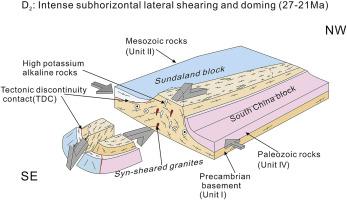当前位置:
X-MOL 学术
›
J. Struct. Geol.
›
论文详情
Our official English website, www.x-mol.net, welcomes your
feedback! (Note: you will need to create a separate account there.)
Lateral subhorizontal middle to lower crustal flow in response to continental collision: evidence from the Diancang Shan complex along the Ailao Shan-Red River belt, Southeastern Tibetan Plateau
Journal of Structural Geology ( IF 2.6 ) Pub Date : 2021-02-01 , DOI: 10.1016/j.jsg.2020.104234 Jiaxin Yan , Tieying Zhang , Junlai Liu , Xiaoyu Chen , Wei Chen , Hai Nam Dao
Journal of Structural Geology ( IF 2.6 ) Pub Date : 2021-02-01 , DOI: 10.1016/j.jsg.2020.104234 Jiaxin Yan , Tieying Zhang , Junlai Liu , Xiaoyu Chen , Wei Chen , Hai Nam Dao

|
Abstract How middle to lower crust in Southeastern Tibetan Plateau flowed in response to the Indian-Eurasian continental collision remains hotly debated in the last decades. Metamorphic complexes along crustal mobile zones, e.g., the Diancang Shan (DCS) complex along the Ailao Shan-Red River (ASRR) metamorphic belt may provide key knowledge on our understanding of the middle-lower crustal flow during the collision. In this contribution, integrated structural, microstructural, kinematic, and thermo-chronological studies of the DCS complex reveal that the complex constitutes a destructed A-type dome. High-grade metamorphic rocks of Proterozoic protoliths form the core (Unit I) that is covered by low-grade metamorphic rocks of Mesozoic age in the limbs (Unit II). The eastern limb of the DCS dome is cut by a normal shear zone (Unit III). Three phases (D1, D2 and D3) of Cenozoic deformation structures are recognized in the complex. The D1 and D2 structures constitute the dominant structural style of the Units I and II. The D1 structures consist of penetrative S1 foliations, mineral lineations (L1), symmetrical intrafolial folds (F1) and tectonic lenses of granitic and quartz veins in rocks from the Units I and II. Mylonitic foliations (S2//S1), NNW-SSE plunging subhorizontal stretching lineations (L2), widespread A-type folds (F2), asymmetric porphyroclasts and tectonic lenses form the dominant structural styles in the D2 deformation. D3 structures are new foliations S3 and hot striae L3 in the normal-slipping shear zone (Unit III). The S2//S1 foliations define the domal framework of the DCS complex, which is truncated by the D3 shear zone. The dome is NW-SE elongated and has a hinge line paralleling to the L2//L1 stretching lineations. Synthetic analysis of structural and microstructural styles, and kinematic vorticity data estimated by rotated rigid porphyroclast method (0.38–0.69) and oblique grain-shape/quartz c-axis-fabric method (0.72–0.98) implies that the D1 and D2 deformations formed a progressive process from early pure shear-dominated (D1) to simple shear-dominated (D2) shearing. Shear sense indicators from different parts (Units I and II) of the dome are compatible with top-to-the southeast shearing during D2 deformation. It is shown that the D1-D2 deformation was characterized by a successive process from penetrative flow (D1) and ductile shearing at middle to lower crustal levels to doming (D2) that was coeval with exhumation of the DCS complex since 27 Ma or earlier. We conclude that these processes, i.e., the penetrative flow, ductile shearing, doming and exhumation of the DCS complex, were attributed to lateral subhorizontal middle to lower crustal flow along the ASRR metamorphic belt in the Southeastern Tibetan Plateau during the Indian and Eurasian plate collision.
中文翻译:

响应大陆碰撞的横向亚水平中下地壳流动:来自青藏高原东南部哀牢山-红河带沿线点苍山杂岩的证据
摘要 在过去的几十年里,青藏高原东南部中下地壳如何流动以响应印度-欧亚大陆碰撞一直是争论不休的话题。沿地壳移动带的变质杂岩,例如沿哀牢山-红河(ASRR)变质带的点仓山(DCS)杂岩,可能为我们理解碰撞过程中中下地壳流动提供关键知识。在这项贡献中,对 DCS 复合体的综合结构、微观结构、运动学和热年代学研究表明,该复合体构成了一个被破坏的 A 型圆顶。元古界原岩的高级变质岩形成岩心(I 单元),四肢(II 单元)被中生代低变质岩覆盖。DCS 圆顶的东翼被正常剪切带(单元 III)切割。在复合体中识别出新生代变形结构的三个阶段(D1、D2 和 D3)。D1和D2结构构成了I和II单元的主要结构风格。D1 构造包括穿透性 S1 叶理、矿物线理 (L1)、对称叶内褶皱 (F1) 以及来自单元 I 和单元 II 的岩石中的花岗岩和石英脉的构造透镜。糜棱片理 (S2//S1)、NNW-SSE 俯冲亚水平拉伸线理 (L2)、广泛的 A 型褶皱 (F2)、不对称的斑状碎屑和构造透镜构成了 D2 变形中的主要结构样式。D3 结构是法向滑动剪切带(单元 III)中的新叶理 S3 和热条纹 L3。S2//S1 叶理定义了 DCS 复合体的圆顶框架,它被 D3 剪切带截断。穹顶是 NW-SE 拉长的,并具有平行于 L2//L1 拉伸线的铰链线。结构和微观结构样式的综合分析,以及通过旋转刚性斑岩碎屑法 (0.38–0.69) 和斜纹/石英 c 轴织物法 (0.72–0.98) 估计的运动涡度数据意味着 D1 和 D2 变形形成了一个从早期纯剪切主导 (D1) 到简单剪切主导 (D2) 剪切的渐进过程。穹顶不同部分(I 单元和 II 单元)的剪切感指标与 D2 变形期间从顶部到东南方向的剪切兼容。结果表明,D1-D2 变形的特征是从中到下地壳水平的穿透流 (D1) 和韧性剪切到隆起 (D2) 的连续过程,隆起 (D2) 与 DCS 复合体自 27 Ma 或更早以来的折返同时期。
更新日期:2021-02-01
中文翻译:

响应大陆碰撞的横向亚水平中下地壳流动:来自青藏高原东南部哀牢山-红河带沿线点苍山杂岩的证据
摘要 在过去的几十年里,青藏高原东南部中下地壳如何流动以响应印度-欧亚大陆碰撞一直是争论不休的话题。沿地壳移动带的变质杂岩,例如沿哀牢山-红河(ASRR)变质带的点仓山(DCS)杂岩,可能为我们理解碰撞过程中中下地壳流动提供关键知识。在这项贡献中,对 DCS 复合体的综合结构、微观结构、运动学和热年代学研究表明,该复合体构成了一个被破坏的 A 型圆顶。元古界原岩的高级变质岩形成岩心(I 单元),四肢(II 单元)被中生代低变质岩覆盖。DCS 圆顶的东翼被正常剪切带(单元 III)切割。在复合体中识别出新生代变形结构的三个阶段(D1、D2 和 D3)。D1和D2结构构成了I和II单元的主要结构风格。D1 构造包括穿透性 S1 叶理、矿物线理 (L1)、对称叶内褶皱 (F1) 以及来自单元 I 和单元 II 的岩石中的花岗岩和石英脉的构造透镜。糜棱片理 (S2//S1)、NNW-SSE 俯冲亚水平拉伸线理 (L2)、广泛的 A 型褶皱 (F2)、不对称的斑状碎屑和构造透镜构成了 D2 变形中的主要结构样式。D3 结构是法向滑动剪切带(单元 III)中的新叶理 S3 和热条纹 L3。S2//S1 叶理定义了 DCS 复合体的圆顶框架,它被 D3 剪切带截断。穹顶是 NW-SE 拉长的,并具有平行于 L2//L1 拉伸线的铰链线。结构和微观结构样式的综合分析,以及通过旋转刚性斑岩碎屑法 (0.38–0.69) 和斜纹/石英 c 轴织物法 (0.72–0.98) 估计的运动涡度数据意味着 D1 和 D2 变形形成了一个从早期纯剪切主导 (D1) 到简单剪切主导 (D2) 剪切的渐进过程。穹顶不同部分(I 单元和 II 单元)的剪切感指标与 D2 变形期间从顶部到东南方向的剪切兼容。结果表明,D1-D2 变形的特征是从中到下地壳水平的穿透流 (D1) 和韧性剪切到隆起 (D2) 的连续过程,隆起 (D2) 与 DCS 复合体自 27 Ma 或更早以来的折返同时期。




















































 京公网安备 11010802027423号
京公网安备 11010802027423号